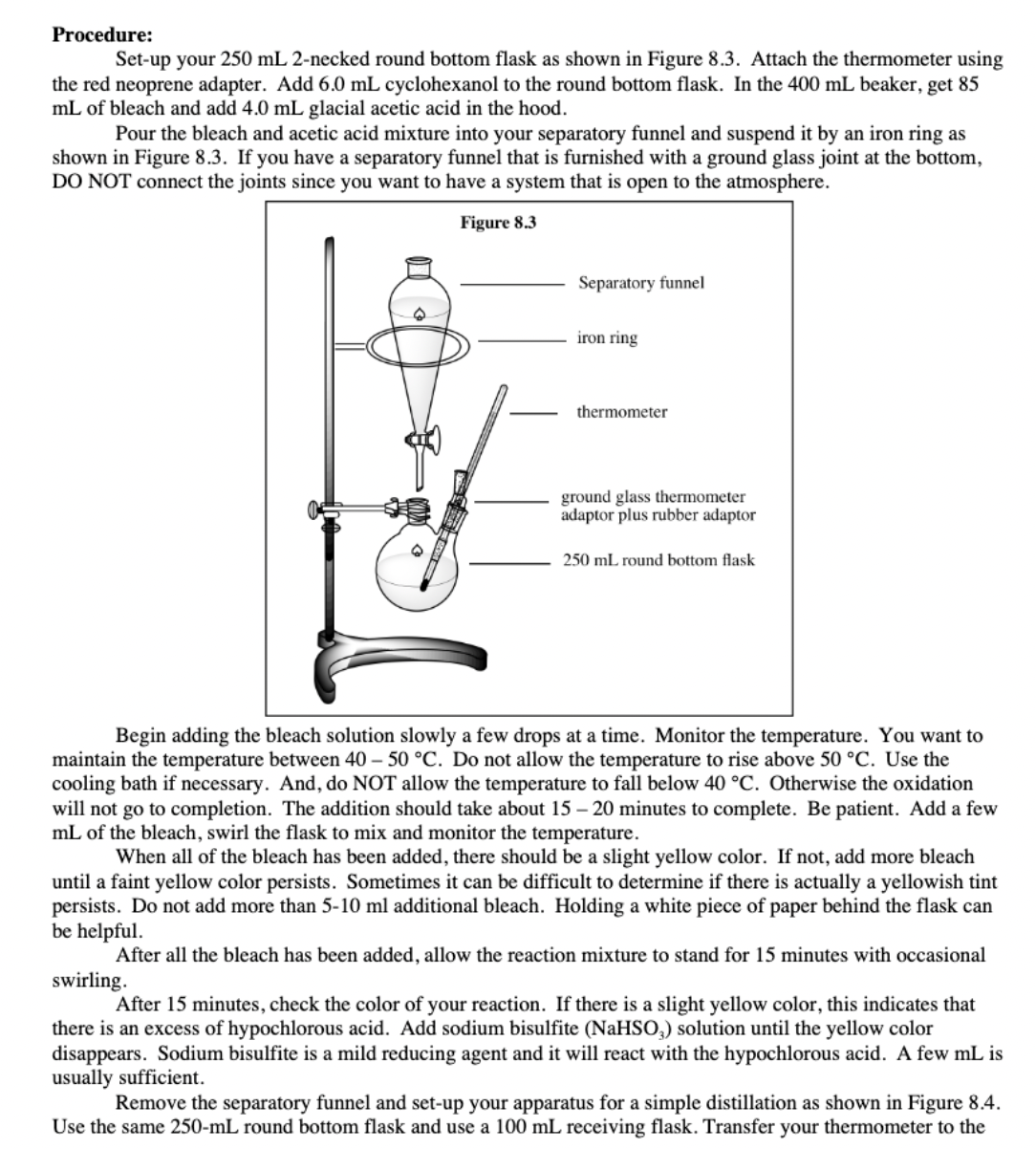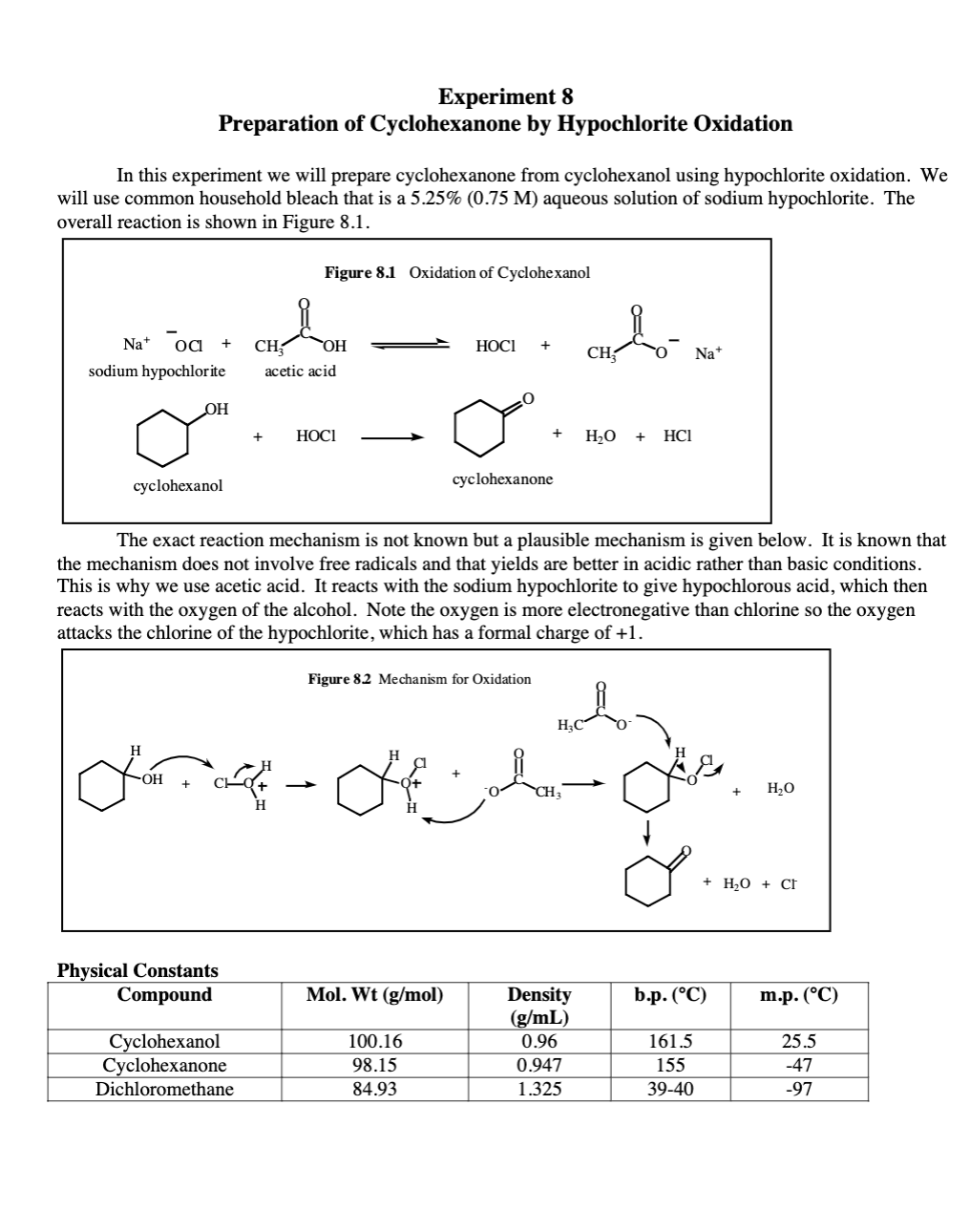Chemistry
10th Edition
ISBN:9781305957404
Author:Steven S. Zumdahl, Susan A. Zumdahl, Donald J. DeCoste
Publisher:Steven S. Zumdahl, Susan A. Zumdahl, Donald J. DeCoste
Chapter1: Chemical Foundations
Section: Chapter Questions
Problem 1RQ: Define and explain the differences between the following terms. a. law and theory b. theory and...
Related questions
Question
i need to write a background for the expirment can i please get help

Transcribed Image Text:Procedure:
Set-up your 250 mL 2-necked round bottom flask as shown in Figure 8.3. Attach the thermometer using
the red neoprene adapter. Add 6.0 mL cyclohexanol to the round bottom flask. In the 400 mL beaker, get 85
mL of bleach and add 4.0 mL glacial acetic acid in the hood.
Pour the bleach and acetic acid mixture into your separatory funnel and suspend it by an iron ring as
shown in Figure 8.3. If you have a separatory funnel that is furnished with a ground glass joint at the bottom,
DO NOT connect the joints since you want to have a system that is open to the atmosphere.
Figure 8.3
Separatory funnel
iron ring
thermometer
ground glass thermometer
adaptor plus rubber adaptor
250 mL round bottom flask
Begin adding the bleach solution slowly a few drops at a time. Monitor the temperature. You want to
maintain the temperature between 40 – 50 °C. Do not allow the temperature to rise above 50 °C. Use the
cooling bath if necessary. And, do NOT allow the temperature to fall below 40 °C. Otherwise the oxidation
will not go to completion. The addition should take about 15 – 20 minutes to complete. Be patient. Add a few
mL of the bleach, swirl the flask to mix and monitor the temperature.
When all of the bleach has been added, there should be a slight yellow color. If not, add more bleach
until a faint yellow color persists. Sometimes it can be difficult to determine if there is actually a yellowish tint
persists. Do not add more than 5-10 ml additional bleach. Holding a white piece of paper behind the flask can
be helpful.
After all the bleach has been added, allow the reaction mixture to stand for 15 minutes with occasional
swirling.
After 15 minutes, check the color of your reaction. If there is a slight yellow color, this indicates that
there is an excess of hypochlorous acid. Add sodium bisulfite (NaHSO,) solution until the yellow color
disappears. Sodium bisulfite is a mild reducing agent and it will react with the hypochlorous acid. A few mL is
usually sufficient.
Remove the separatory funnel and set-up your apparatus for a simple distillation as shown in Figure 8.4.
Use the same 250-mL round bottom flask and use a 100 mL receiving flask. Transfer your thermometer to the

Transcribed Image Text:Experiment 8
Preparation of Cyclohexanone by Hypochlorite Oxidation
In this experiment we will prepare cyclohexanone from cyclohexanol using hypochlorite oxidation. We
will use common household bleach that is a 5.25% (0.75 M) aqueous solution of sodium hypochlorite. The
overall reaction is shown in Figure 8.1.
Figure 8.1 Oxidation of Cyclohexanol
Na*
OCI
CH;
HOCI
CH:
Na*
sodium hypochlorite
acetic acid
OH
HOCI
H2O
HCI
cyclohexanol
cyclohexanone
The exact reaction mechanism is not known but a plausible mechanism is given below. It is known that
the mechanism does not involve free radicals and that yields are better in acidic rather than basic conditions.
This is why we use acetic acid. It reacts with the sodium hypochlorite to give hypochlorous acid, which then
reacts with the oxygen of the alcohol. Note the oxygen is more electronegative than chlorine so the oxygen
attacks the chlorine of the hypochlorite, which has a formal charge of +1.
Figure 82 Mechanism for Oxidation
H;C
H
-OH
H2O
+ H,0 + CF
Physical Constants
Compound
Mol. Wt (g/mol)
Density
(g/mL)
b.p. (°C)
m.p. (°C)
Cyclohexanol
Cyclohexanone
Dichloromethane
100.16
0.96
161.5
25.5
98.15
0.947
155
-47
84.93
1.325
39-40
-97
Expert Solution
This question has been solved!
Explore an expertly crafted, step-by-step solution for a thorough understanding of key concepts.
Step by step
Solved in 4 steps

Knowledge Booster
Learn more about
Need a deep-dive on the concept behind this application? Look no further. Learn more about this topic, chemistry and related others by exploring similar questions and additional content below.Recommended textbooks for you

Chemistry
Chemistry
ISBN:
9781305957404
Author:
Steven S. Zumdahl, Susan A. Zumdahl, Donald J. DeCoste
Publisher:
Cengage Learning

Chemistry
Chemistry
ISBN:
9781259911156
Author:
Raymond Chang Dr., Jason Overby Professor
Publisher:
McGraw-Hill Education

Principles of Instrumental Analysis
Chemistry
ISBN:
9781305577213
Author:
Douglas A. Skoog, F. James Holler, Stanley R. Crouch
Publisher:
Cengage Learning

Chemistry
Chemistry
ISBN:
9781305957404
Author:
Steven S. Zumdahl, Susan A. Zumdahl, Donald J. DeCoste
Publisher:
Cengage Learning

Chemistry
Chemistry
ISBN:
9781259911156
Author:
Raymond Chang Dr., Jason Overby Professor
Publisher:
McGraw-Hill Education

Principles of Instrumental Analysis
Chemistry
ISBN:
9781305577213
Author:
Douglas A. Skoog, F. James Holler, Stanley R. Crouch
Publisher:
Cengage Learning

Organic Chemistry
Chemistry
ISBN:
9780078021558
Author:
Janice Gorzynski Smith Dr.
Publisher:
McGraw-Hill Education

Chemistry: Principles and Reactions
Chemistry
ISBN:
9781305079373
Author:
William L. Masterton, Cecile N. Hurley
Publisher:
Cengage Learning

Elementary Principles of Chemical Processes, Bind…
Chemistry
ISBN:
9781118431221
Author:
Richard M. Felder, Ronald W. Rousseau, Lisa G. Bullard
Publisher:
WILEY